How to Sear Scallops Perfectly (Wet vs Dry Scallops Explained)
Master restaurant-style seared scallops at home with this guide, plus how wet vs dry scallops affect your results
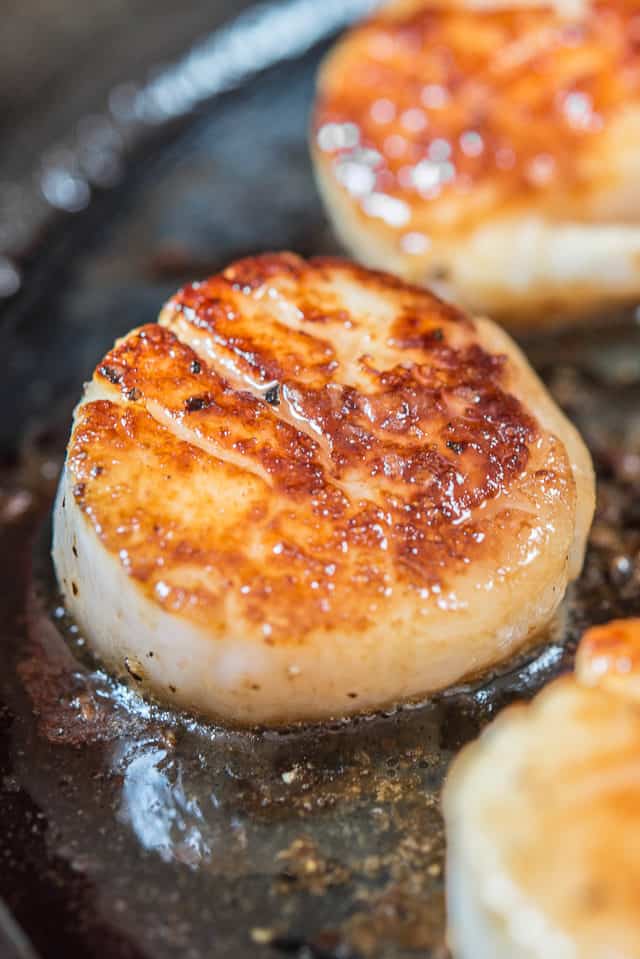
Perfectly seared scallops with a golden-brown crust take a bit of technique — and it starts with knowing the difference between wet and dry scallops. In this step-by-step guide, I’ll show you how to sear scallops like a pro, share the secrets behind restaurant-quality results, and explain why the type of scallop you buy matters more than you think.
Their mildly sweet flavor and that caramelized crust they get when seared in a super hot pan…oh, swoon. Not to mention, they’re really low-maintenance compared to lobster and crab.
What’s funny to me about scallops is a lot of people only order them at restaurants because they’re too intimidated to make them at home.
This is silly!
Scallops are one of the easiest things you can make at home. Im going to teach you how to become a expert also.
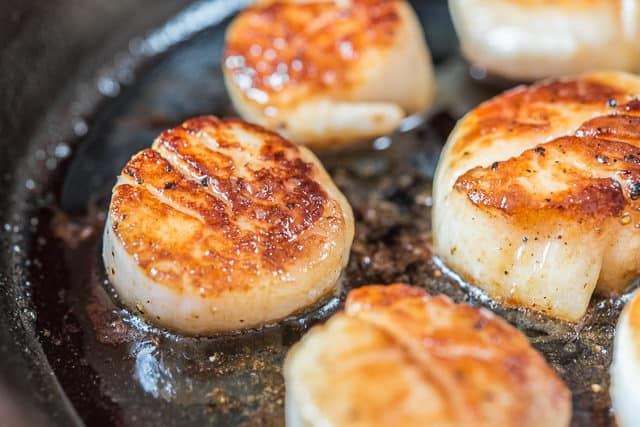
I also love that you just pick them up from the store and don’t have to do any prep with them, aside from seasoning with salt and pepper.

So before we get cooking, let’s talk about buying scallops.
Where to buy scallops:
You want to buy scallops wherever they sell them “dry.”
I’ve noticed more and more grocery stores labeling their scallops as either wet or dry, which I really appreciate because I used to have to ask.
- A wet scallop has been soaked in a preservative phosphate solution. This makes the scallop absorb more water, and when you cook them, they kind of shrivel a bit and don’t brown as well because of that extra liquid. The phosphate solution also gives the scallop an off flavor, and they’re usually not as fresh.
- A dry scallop has not been treated with any chemicals additives or solutions. Compared to the wet scallops, they are darker (more of a beige color, whereas the wet scallops are whiter), and they have a more pure flavor.
If possible, you always want to buy dry scallops.
How to Sear Scallops for a Golden-Brown Crust
The first thing you want to do when you’re searing anything is to pat the outside dry with a paper towel. I do this when I make Pan Seared Steaks too.
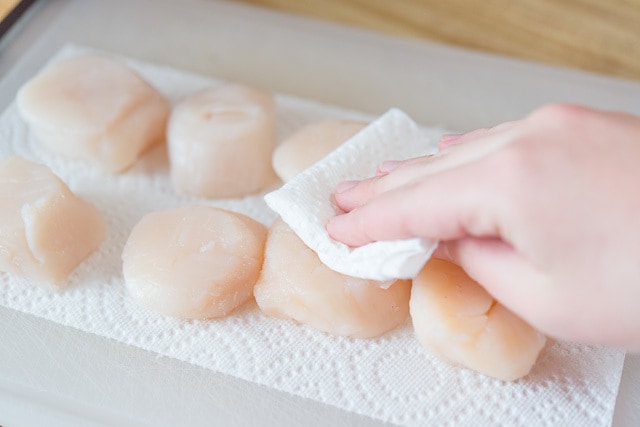
Next, sprinkle the scallops with sea salt and black pepper:
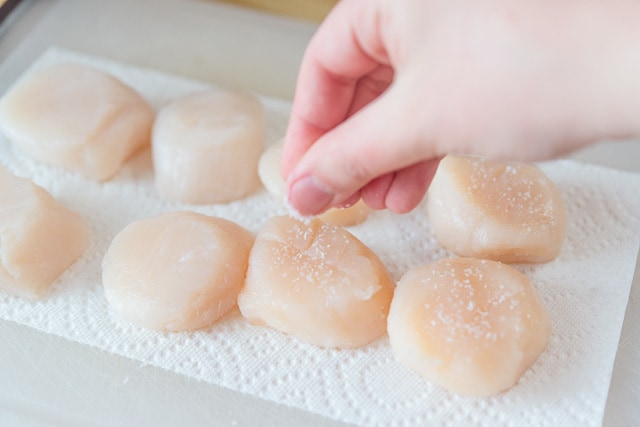
Next grab a skillet, preferably cast-iron. Cast iron pans are my favorite for searing because they retain heat so well and preheat nicely.
Heat up the skillet until it’s really hot, and add some high smoke point oil: I love using Avocado oil

Drop in your scallops, and make sure to give them enough space in the pan so they’re not steaming each other.
This is when I season the other side with salt and pepper:
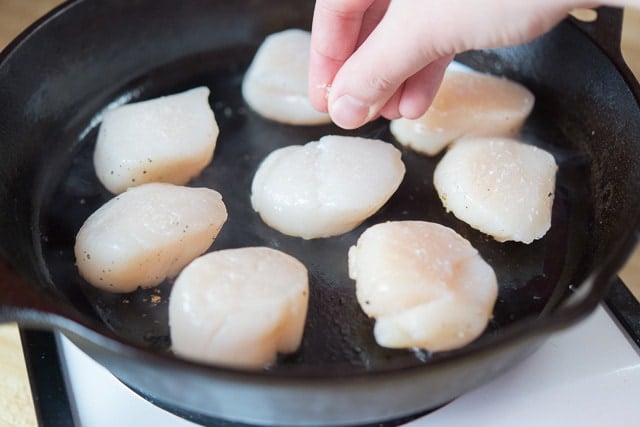
Sear the scallops for about 2 minutes on the first side, then add a small pat of butter to the pan while the other side finishes cooking, to flavor the scallops:
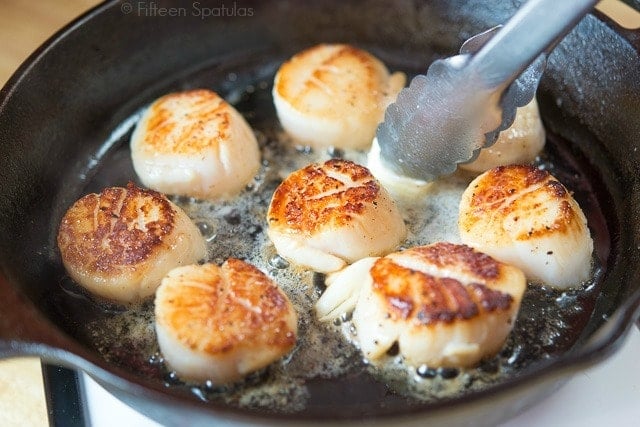
Once the the scallops are done cooking, serve immediately, and make sure to transfer them to another dish for serving. The cast iron retains heat and will continue cooking the scallops unless you take them out.
What goes with seared scallops?
I like serving them with something light, like a salad.
Here is the Salad category of my recipe index for ideas, but the Mexican Corn Salad goes really well in particular, as well as this Arugula Zucchini Salad.
I also have a recipe for Seared Scallops with Bacon Jam and Basil, which is a flavorful compliment to the scallops!
Frequently Asked Questions
You can, but it’s harder to get a good crust. Wet scallops contain added solution, which steams instead of sears. For best results, stick to dry scallops.
Make sure they’re dry, your pan is hot, and you’re using a high-smoke-point oil. Avoid overcrowding the pan — that causes steaming.
Brining can enhance flavor and help with browning. A quick 10-minute saltwater brine can improve texture, especially for wet scallops.
A heavy stainless steel or cast iron pan gives the best crust. Avoid nonstick pans — they don’t get hot enough to brown properly.
Two days max. When they’re fresh, they have a sweet ocean smell, and when they start to spoil they will take on a stinky fish smell.
Yes, but you have to be careful not to cook them further. Heat until they’re just warm enough to eat. I do this in the microwave at half heat.
Did you enjoy the recipe? Please leave a 5-star rating in the recipe card below and/or a review in the comments section further down the page. Or, follow me on Facebook, Instagram or Pinterest!
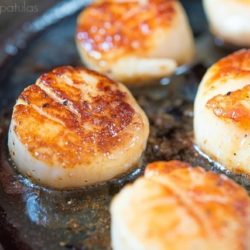
Seared Scallops
Ingredients
For the Scallops:
- 1/2 lb dry sea scallops
- salt
- pepper
- 1 tbsp high smoke point oil like ghee, avocado oil, etc.
- 2 tbsp butter
Ideas for What to Serve with Scallops (optional):
Instructions
- Preheat a cast iron skillet over medium high heat.
- In the meantime, pat the scallops very dry with a paper towel. Sprinkle the sea scallops with salt and pepper, to season.
- When the pan is hot, add the oil, then drop in your scallops, giving them enough room in between so they don’t steam each other. The scallops should make a sizzling noise when you put them in the pan.
- Cook the scallops for 2 minutes, making sure not to move them or touch them at all.
- Flip the scallops over with a pair of tongs, and add the butter to the pan. Let the scallops cook for 1 more minute, basting the scallops with the butter.
- Remove the scallops from the pan and serve!
Nutrition
Nutrition is estimated using a food database and is only intended to be used as a guideline for informational purposes.

195 Comments on “How to Sear Scallops Perfectly (Wet vs Dry Scallops Explained)”
I never knew about wet or dry scallops, I thank you for sharing.
Giang
So glad you found it helpful! Cheers to scallops
I love scallops
Great recipe, finally found someone who is a great scallop cook.
Thanks Ray! Glad you enjoyed!
Thank you. For the tips and what type of scallops to buy. Never knew there were more then one kind of sea scallop.
Cheers! Now you’re an expert! Enjoy!
Thank you for your recipe . I love scallops but HATE sand ! I ve always had bad luck with sandy scallops even though I would wash them and get them from good sources . Any advice on how to clean a scallop ?I bought fresh frozen scallops yesterday hoping they will be ok .( fingers crossed)
Never use butter (unless clarified) for searing scallops. This is just basic cooking 101!
Hi Angelo, we are using a high smoke point oil to sear the scallops for this recipe